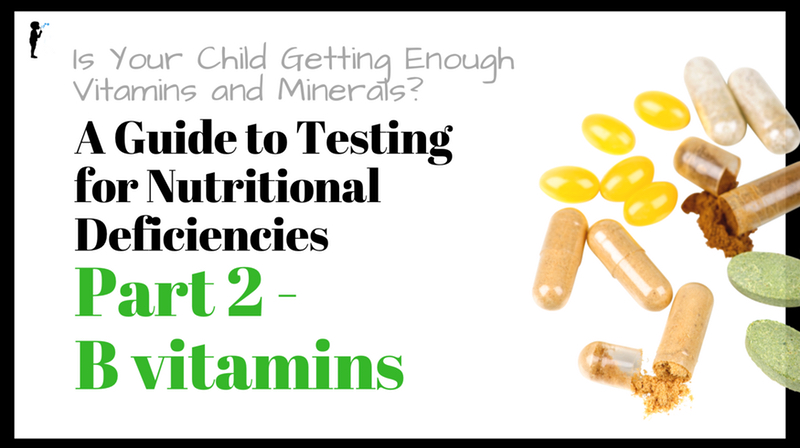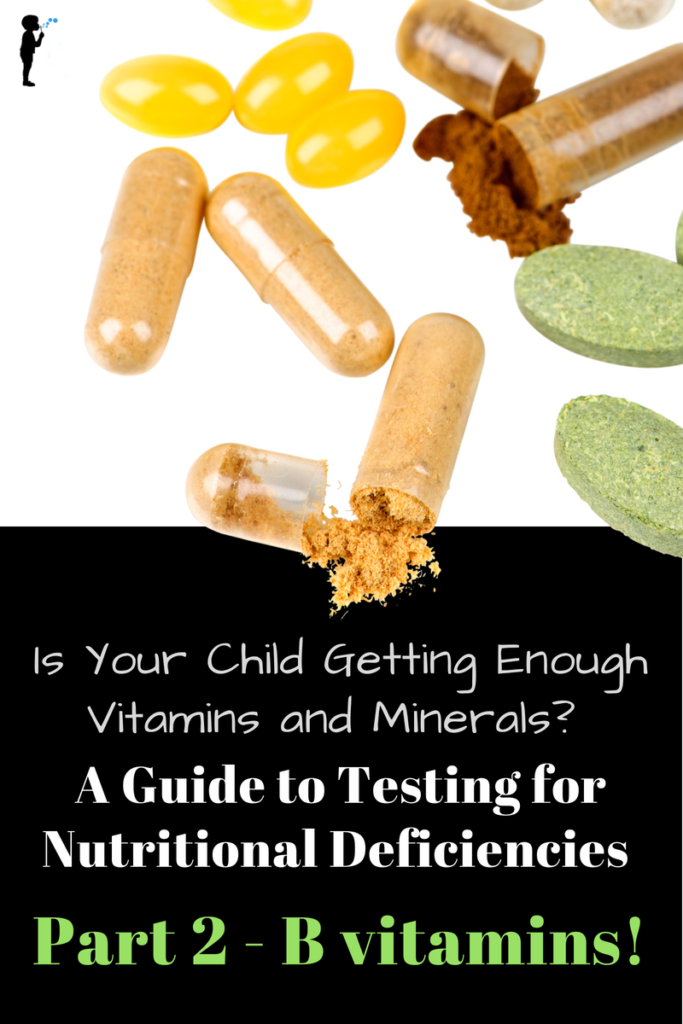
Is Your Child Getting Enough Vitamins and Minerals? A Guide to Testing for Nutritional Deficiencies (Part 2 – B Vitamins!)
Could your child have a B vitamin deficiency?
This article is the second in a series all about nutritional deficiencies. In these articles I will discuss some of the most common vitamin and mineral deficiencies seen in children and adolescents. I will also explain the lab tests that can be used to comprehensively assess your child’s nutritional status.
If you missed it, here is Part 1: Vitamin D.
First, let’s recap why vitamin and mineral deficiencies happen.
Common Causes of Nutrient Deficiencies:
- Lack of adequate intake of vitamins or minerals
- Increased need for nutrients
- Health conditions may affect the ability to absorb nutrients from the diet
- Consuming high amounts of a food (or medication) that inhibits the absorption of another vitamin or mineral
Part 2: B Vitamin Deficiencies
Importance of B Vitamins
B-Vitamins are a diverse group of water-soluble nutrients that are necessary for many functions in the body. I will focus here on vitamin B6, vitamin B12, and folate since these are some of the most common nutrient deficiencies in the U.S. and there are readily available lab tests for deficiencies.
The B Vitamins include:
- Vitamin B1/Thiamin
- Vitamin B2/Riboflavin
- Vitamin B3/Niacin
- Vitamin B5/Pantethine
- Vitamin B6/Pyridoxine
- Vitamin B7/Biotin
- Vitamin B9/Folate
- Vitamin B12/Cobalamin
Cellular Health
Folate and vitamin B12 are essential for our cells to divide, mature, and repair. This process starts with the replication of genetic material contained in a cell’s DNA. If a cell isn’t able to properly replicate and repair its DNA this can lead to anemia, immune dysfunction, cancers, and other health issues.
In utero, a growing baby has lots of quickly dividing and maturing cells. Low folate intake during pregnancy can cause specific birth defects, called neural tube defects where the brain, spine, or spinal cord don’t grow properly.1
Mood and Energy
Adequate vitamin B6 levels are essential for healthy mood and energy levels. In the brain, vitamin B6 helps to create the neurotransmitters serotonin, GABA, glycine, and dopamine. Vitamin B6 is also necessary for the synthesis of hemoglobin, the oxygen carrying protein in red blood cells. B6 is also important for nervous system function; too much or too little of this nutrient can cause nerve pain (neuropathy).2
Heart Health and Inflammation
Vitamin B6, vitamin B12, and folate also seem to be important for cardiovascular health. Low levels of these vitamins can cause elevations in homocysteine, an inflammatory marker that is associated with risk for blood clots, heart disease, and stroke. More research is still needed to find out if supplementing with B vitamins can reduce heart disease risk in people who have elevated homocysteine levels.3, 4, 5
Adrenal Function, Stress, and a Healthy Immune System
Many of the B vitamins support adrenal function. The adrenal glands sit on top of the kidneys and secrete “stress” hormones including cortisol. Stress is a normal part of life, but when our bodies are over-stressed for a long period of time cortisol can become chronically elevated, which can then suppress normal immune function. B-vitamins can support a healthy stress response and help our immune systems to function more optimally.6,7
Signs and Symptoms of B Vitamin Deficiencies
Because there are so many B vitamins, the signs and symptoms of deficiencies are quite varied. The most common sign of folate or vitamin B12 deficiency is megaloblastic anemia. Anemia occurs when red blood cell levels in the body become too low. This can affect energy and oxygen levels. Common symptoms of anemia include fatigue, weakness, pale skin, lightheadedness, and shortness of breath.
Studies have shown that low folate intake is correlated with increased risk for colon cancer, breast cancer, cardiovascular disease, Alzheimer’s disease, and certain childhood cancers (Wilms’ tumors, neuroblastoma, ganglioneuroblastoma, and ependymoma).1
Severe vitamin B6 deficiency isn’t common, but it can cause neurological issues like irritability, seizures, neuropathy, and depression, as well as ulcers of the mouth and skin.
How common are B vitamin deficiencies?
B vitamin deficiencies are actually pretty common in the U.S. A recent report by the Centers for Disease Control (CDC) found that 10.5% of all people in the U.S. over the age of 1 year old have deficient levels of vitamin B6. Approximately 2% of children and adults are deficient in vitamin B12, and about 1% have low folate levels.8 In teens, these numbers are even higher. It’s estimated that 19% of kids ages 14-18 are deficient in folate, 18% are deficient in vitamin B6, and 7% are low in vitamin B12.9
Risk Factors for B Vitamin Deficiencies
Lack of vitamins in the diet
In an effort to reduce the occurrence of neural tube defects and other diseases caused by vitamin and mineral deficiencies, most wheat flour sold in the U.S. is fortified with the B vitamins folic acid, niacin, thiamine, and riboflavin, as well as iron. Because of this, most children do consume the Recommended Daily Allowance (RDA) of these B vitamins. However, children who eat a gluten-free or Paleo diet might not get sufficient amounts from their diet. People who eat a vegetarian or vegan diet are at greater risk for vitamin B12 deficiency because natural sources of vitamin B12 are primarily animal proteins.
Malabsorption
Chronic diseases that affect the digestive tract can decrease absorption of vitamins and minerals. These health conditions include celiac disease and inflammatory bowel disease (ulcerative colitis and crohns). There are also medications that can deplete levels of folate, B12, and B6.10
MTHFR Genetic Variations
A common genetic variation called MTHFR can affect how a person’s body uses folate and folic acid. Approximately 10-40% of people have an inherited variation in their MTHFR genes. The MTHFR genes are in part responsible for turning folic acid into the biologically active form of folate, methylfolate (aka 5-MTHF). Having an MTHFR variation reduces a person’s ability to use the synthetic folic acid that is found in fortified foods and most vitamin supplements. This may lead to folate deficiencies, because the synthetic folic acid can pool in the blood instead of being activated for cellular use.
Testing Options for B Vitamin Levels
Folate Testing
Folate is a generic term that includes natural folates and synthetic folic acid. In order for the body to use folate, it has to be transformed by the enzyme methylenetetrahydrofolate reductase (a.k.a. MTHFR) into the active metabolite 5-methyltetrahydrofolate (5-MTHF). Unfortunately, the blood test for folate doesn’t differentiate between types of folate. Blood folate levels can be high even when the body doesn’t actually have enough of the active 5-MTHF for its needs.
For example, consuming large amounts of folic acid will raise total blood folate levels, but many people with MTHFR mutations aren’t able to transform that folic acid into 5-MTHF. Because of this, having a normal blood concentration of folate doesn’t always mean there isn’t a deficiency.
Testing blood folate levels can still be useful, but it provides only one part of the total picture. Combining it with additional tests for homocysteine, methylmalonic acid, and vitamin B12 can provide more precise information about nutritional status.
Vitamin B12 Testing
Vitamin B12 is also called cobalamin. Like folate, there are many different forms of cobalamin and blood tests don’t differentiate between them. Methylcobalamin and 5-deoxyadenosylcobalamin are the active forms of vitamin B12 that are needed by the body for cellular functions. Having normal (or even high) blood levels of vitamin B12 doesn’t guarantee that someone actually has enough vitamin B12 available for cellular use. This test can be combined with homocysteine and methymalonic acid to get a better idea if there is a deficiency.
Homocysteine
Homocysteine is an amino acid (i.e. a protein component). Homocysteine plays an important role in a biochemical pathway called the methylation cycle. When this cycle is functioning well, homocysteine is naturally transformed into methionine or cysteine. This process requires plenty of vitamin B6, vitamin B12, and folate. Because of this, elevated levels of homocysteine in the blood may point to deficiencies of these vitamins. Although having elevated homocysteine levels may make a doctor suspect B vitamin deficiencies, on it’s own it doesn’t tell us which vitamin is low. Homocysteine is best used in combination with other tests.
Methylmalonic Acid
Methylmalonic acid (MMA) is produced by the body in very small amounts. Vitamin B12 is required for methylmalonic acid (MMA) to be converted to another substance called succinyl-CoA. If there isn’t enough B12 around, MMA levels will build up in the blood and urine. Therefore, MMA can be used as an early and specific indicator of vitamin B12 deficiency. You can see high levels of MMA even when blood concentrations of vitamin B12 are normal.
Although very rare, elevated levels of MMA in newborns and young children could also indicate an inherited metabolic disorder called methylmalonic acidemia.11
Vitamin B6 Testing
Vitamin B6 has 6 distinct forms: pyridoxal, pyridoxol, and pyridoxamine and then each has a corresponding 5′-phosphate ester. The form of vitamin B6 that we should care most about is Pyridoxal 5′-phosphate (P5P). P5P is the active form of vitamin B6 that the body uses for hemoglobin production and nervous system functions. Different laboratories offer a variety of testing methods for vitamin B6 levels. Most labs test blood levels of all the forms of vitamin B6 combined, but others offer specific testing for P5P. Since P5P is the form of vitamin B6 that our bodies need, this would be the best testing option to look for a deficiency.
Should I supplement my child with B Vitamins?
Although B vitamins are generally considered safe, it’s definitely possible to get too much of a good thing. I don’t usually recommend high dose B vitamin supplements for kids unless it’s for a specific health condition. If you’d like to give your kids B vitamins, a children’s multivitamin is usually good place to start. Multivitamins can be especially useful for picky eaters. For more information about high quality multivitamins see What’s In Your Child’s Multivitamin??
Stay tuned for Part 3: Iron!
References:
- Linus Pauling Institute. Retrieved May 04, 2018, from http://lpi.oregonstate.edu/mic/vitamins/folate#disease-prevention
- Linus Pauling Institute. Retrieved May 04, 2018, from http://lpi.oregonstate.edu/mic/vitamins/vitamin-B6#function
- Wang X, Qin X, Demirtas H, et al (2007). Efficacy of folic acid supplementation in stroke prevention: a meta-analysis. Lancet. 369(9576):1876-1882.
- Huang T, Chen Y, Yang B, Yang J, Wahlqvist ML, Li D. Meta-analysis of B vitamin supplementation on plasma homocysteine, cardiovascular and all-cause mortality. Clin Nutr. 2012;31(4):448-454.
- Ganguly P, and Alam S (2015). Role of homocysteine in the development of cardiovascular disease. Nutrition Journal. 14(6).
- Stough C1, Scholey A, Lloyd J, Spong J, Myers S, Downey LA (2011). The effect of 90 day administration of a high dose vitamin B-complex on work stress. Human Psychopharmacology. (7):470-6.
- Qian B, Shen S, Zhang J, Jing P (2017). Effects of Vitamin B6 Deficiency on the Composition and Functional Potential of T Cell Populations. Journal of Immunology Research.
- Pfeiffer C, Sternberg M, Schleicher R, Haynes B, Rybak M, Pirkle J (2013 Jun). CDC’s Second National Report on Biochemical Indicators of Diet and Nutrition in the US Population is a valuable tool for researchers and policy makers. Journal of Nutrition. 143(6): 938S–947S.
- Environmental Working Group. How Much is Too Much? : Appendix B: Vitamin and Mineral Deficiencies in the U.S. Retrieved May 04, 2018, from https://www.ewg.org/research/how-much-is-too-much/appendix-b-vitamin-and-mineral-deficiencies-us#.WuuIJ8gh2t8
- Linus Pauling Institute. Retrieved May 04, 2018, from http://lpi.oregonstate.edu/mic/vitamins/folate#deficiency
- American Association for Clinical Chemistry. Retrieved May 04, 2018, from https://labtestsonline.org/tests/methylmalonic-acid




